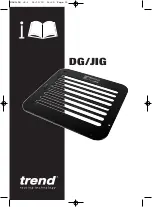
www.scheppach.com /
+(49)-08223-4002-99 /
+(49)-08223-4002-58
9. Cleaning and maintenance
WARNING:
For your own safety, turn the switch off and remove
plug from power source outlet before any operation of
maintenance on our drill press.
Keep your appliance clean.
Be careful some household cleaning products and
solvents such as benzine, trichloroethene, chloride,
ammonium, etc., can damage plastic parts.
To avoid motor darnage, blow out or vacuurn fre
-
quently this motor to keep drill press dust from inter
-
fering with normal motor ventilation.
Power cord.
To avoid shock or fire hazard, if the power cord is
worm or cut, or damaged in any way, have it replace
immediately.
Lubrication.
All of the ball bearings are packed with grease at the
factory. No further lubrication is required.
Periodically lubricate the splines -grooves -in the
spindle.
To lubricate the splines, bring do the quill and ject
the grease into the spindle from the top of the pulley.
Bring the quill up and down a few times.
Maintenance
There are no parts inside the equipment which
require additional maintenance.
10. Storage/Transport
Store the equipment and accessories out of
children’s reach in a dark and dry place at above
freezing temperature. The ideal storage temperature
is between 5 and 30 °C. Store the electric tool in its
original packaging.
m
Attention! Unplug the machine!
The appliance must unconditionally be secured
against falling or turning down during transport.
The appliance can be lifted on the left and right grin
-
ding wheel / belt sander cover. Power cable, flexible
lamp shaft etc. should not be used for transport
purpose.
11. Electrical connection
The installed electric motor is completely wired ready
tor operation.
The customer‘s connection to the power supply sys
-
tem, and any extension cables that may be used,
must conform with local regulations.
Defective electrical connection cables
Electrical connection cables offen suffer insulation
darnage.
Possible causes are:
•
Punch points when connection cables are run
through window or door gaps.
3
Hold the feed handle at this position.
4
Spin the lower nut (B2) down to contact the depth
stop lug (13) on the head.
5
Spin the upper nut (B1) down and tighten against
the lower nut.
6
The chuck and the drill bit wiII now be stopped
after traveling downward the distance selected on
the depth scale.
Depth scale method, Fig. 6
Note: for this method, with the spindle in its upper po
-
sition the tip of the drill bit must be just slightly above
the top of the workpiece.
1
Switch off the machine, lower the drill so far until
the indicator (g) points at the desired drilling depth
of the depth scale (e).
2
Turn the lower nut (B2) downwards until it reaches
the lower stop (13).
3
Lock the lower nut (B1) against the upper nut.
4
The chuck and the drill bit will now be stopped
after traveling downward the distance selected on
the depth scale.
Positioning table and workpiece, Fig. 15
Always place a piece of back up material (H) (‘wood,
plywooood...) on the table undemeath the workpiece
(B). This wiII prevent splitering or making a heavy
burr on the underside of the workpieces as the drill
bit breaks through. To keep the back up material from
spinning out of control it must contact the left side of
the column as illustrated.
Warning:
to prevent the work piece or the backup material from
being torn from your hand whiile drilling, position
them to the left side of the column. If the work piece
or the backup material are not long enough to reach
the column, clamp them to the table. Failure to do this
could result in personal injury.
Note: for small pieces that cannot be clamped to the
table, use a drill press vise (Optional accessory).
The vice must be clamp or bolt to the table to avoid
injury from spinning work and vise or tool breakage.
Drilling a hole.
Make a dent in the workpiece where you want the
hole, using a center punch or a sharp nail. Before
turning the switch on, bring the drill down to the work
-
piece lining it up with the hole location.
Turn the switch on and pull down on the feed handles
with onIy enough effort to allow the drill to cut.
FEEDING TOO SLOWLY might cause the drill bit to
burn.
FEEDING TOO RAPIDLY might stop the motor,
cause the bett or drill to slip, tear the workpiece loose,
or break the drill bit.
When drilling metal, it may be necessary to lubricate the
tip of the drill with motor oil to prevent burning the drill bit.
24 / 124
GB
Содержание dp13 5906805901
Страница 2: ...600 1 min A 1 900 1 min B 2 1200 1 min C 3 1750 1 min D 4 2600 1 min E 5 C 2 A B D E 1 2 3 4 5 2 124 ...
Страница 118: ... www scheppach com service scheppach com 49 08223 4002 99 49 08223 4002 58 118 124 ...
Страница 119: ... www scheppach com service scheppach com 49 08223 4002 99 49 08223 4002 58 119 124 ...
Страница 120: ... www scheppach com service scheppach com 49 08223 4002 99 49 08223 4002 58 120 124 ...
















































